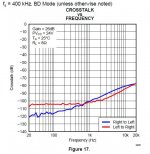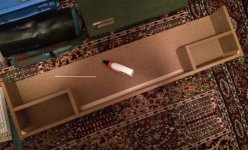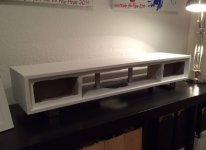Well, here is what the data sheet says about crosstalk between R and L on the same chip.
If that is not enough separation then use separate PBTL boards for each channel with a supply for each.
🙂
***
The datasheet doesn't address the issue of running two chips off the same supply - it only applies to a single chip and the crosstalk between the L and R channels on that single chip. Running multiple chips off a single supply could degrade things, especially if the supply isn't capable of enough peak output. From a purist standpoint it's better to have completely independent supplies.
What is the design based on? bass reflex or TL?
(...) sound could probably be vastly improved if you used a baffle step correction filter to attenuate the highs to balance out the highs vs bass. Something like a 1mH and 10ohm resistor in parallel and that put in series between amp and positive driver terminal.
Thanks for your suggestion about the baffle step correction, xrk971! I will futher play around with these.
I kind of merged two seperate designs together on this one (without knowing what I was exactly doing and how it will all end up).
The baffle height is 13,4cm, the same as these diy RS100-PC-Speakers are in width. So I used the same R-L-C correction as I have in these diy's, which is 0.72mH, 22µF, 3.9Ω. The enclosure volume is reduced from about 5l (bassreflex) to 1.7l (closed).
The sub's enclosure has the same volume which it has had in its origin 'Creative' bassreflex cube of about 12l, without any R-L-C correction. Now it's just downfiring with two 3,5cm backfiring BR's instead of one single 5cm.
The whole outside measures 90cm width x 13,4cm height x 21,6cm depth, 12mm fibreboard (MDF).
It still sounds very 'direct' in the mids while lacking highs. Voices, acoustic guitars and such are quite awesome, nearly as if they'd be playing live right in front of you. Unfortunately the upper highs are too reserved, hi-hats and cymbals are sounding way too silent.
Well, the RS100 is a mid/sub driver, I guess it could be hard getting sweet highs out of them, I should have considered this before..
Attachments
Thanks for your suggestion about the baffle step correction, xrk971! I will futher play around with these.
I kind of merged two seperate designs together on this one (without knowing what I was exactly doing and how it will all end up).
The baffle height is 13,4cm, the same as these diy RS100-PC-Speakers are in width. So I used the same R-L-C correction as I have in these diy's, which is 0.72mH, 22µF, 3.9Ω. The enclosure volume is reduced from about 5l (bassreflex) to 1.7l (closed).
The sub's enclosure has the same volume which it has had in its origin 'Creative' bassreflex cube of about 12l, without any R-L-C correction. Now it's just downfiring with two 3,5cm backfiring BR's instead of one single 5cm.
The whole outside measures 90cm width x 13,4cm height x 21,6cm depth, 12mm fibreboard (MDF).
It still sounds very 'direct' in the mids while lacking highs. Voices, acoustic guitars and such are quite awesome, nearly as if they'd be playing live right in front of you. Unfortunately the upper highs are too reserved, hi-hats and cymbals are sounding way too silent.
Well, the RS100 is a mid/sub driver, I guess it could be hard getting sweet highs out of them, I should have considered this before..
The RS100-4's should have plenty of HF sound in them - specs show good out 20kHz. Your sealed chambers are rather small for how high the Qts is though. 3L would have been better to get a little more reach down to 150Hz. Are you scavenging the sub from an old Creative sub? Down firing is good as the 2.1 amp has a high XO at 340Hz so you want to limit the direct output in sub. The BSC you have may be close with 0.72mH already. Just need to add some more resistance to it and maybe add 0.3mH coil.
(...)Are you scavenging the sub from an old Creative sub? (...) The BSC you have may be close with 0.72mH already. Just need to add some more resistance to it and maybe add 0.3mH coil.
😱 Sorry, I wrote 0.72mH, it's actually 0.27mH. I will definitely try your suggested values.
Yes, the sub is from an old Creative 2.1 system and the subfrequency part seems to sound ok, though it becomes more 'tidy' somehow by closing the BR's on the back with some foam..
Thx for the feedback concerning the PS - at least I can give it a try with two boards per PS.
Has anyone added the Giancarlo anti-pop mod to their Sure board? I powered up the laptop-type PS with it plugged into the board and got a loud pop. Now I get the pop every time I power on the board. I tried a switch between STBY and GND, but when I open it after applying power, I still get the loud pop. Did I blow something that first time I powered up the PS with it plugged in?
If anyone has pictures of the mod on the Sure board, that would be appreciated, as I am a noob, and don't trust myself to read the simple schematic, below.
TPA3116D2 Boards - diyAudio
If anyone has pictures of the mod on the Sure board, that would be appreciated, as I am a noob, and don't trust myself to read the simple schematic, below.
TPA3116D2 Boards - diyAudio
(...) Something like a 1mH and 10ohm resistor (...)
Wow, that hint really saved my project. 1mH/10ohm made the Dayton's cheeky mids sound way more tame, after some more trial and error they're at 1mH/15ohm/5.6µF now and the whole sound became how I want it to be, sort of straight, nice balanced to my ears with adjustable low end.
And you've been right, the RS100 can do treble, the hi-hats completely returned.
Great stuff, thank you so much!

@Crossrh: Strange, my sure3116 has just a slight turn-off pop, like pulling a needle off a record. Turning it on is dead silent. Otherwise it's still at 12V/6A, so below the voltage commonly recommented.
The Feixiang 2.1 has a quite hard turn-on pop instead, with no audible turn-off pop (at 19V/6A).
The Feixiang 2.1 has a quite hard turn-on pop instead, with no audible turn-off pop (at 19V/6A).
Last edited:
Wow, that hint really saved my project. 1mH/10ohm made the Dayton's cheeky mids sound way more tame, after some more trial and error they're at 1mH/15ohm/5.6µF now and the whole sound became how I want it to be, sort of straight, nice balanced to my ears with adjustable low end.
And you've been right, the RS100 can do treble, the hi-hats completely returned.
Great stuff, thank you so much!
You are welcome! The coil/resistor/cap BSC is a wonderful tool that tames harsh sounding drivers in thin baffles, albeit, with some loss of sensitivity - but better that that an un-listenable speaker 🙂 My biggest complaint is that coils cost too much for what they are. I should go to salvage shops or strip transformers from old CRT's and microwaves apart and roll-my-own.
Glad it worked out for you. Do have measurements of the new sound?
I agree all big coils are expensive and some small ones too, as it is a manual operation to wind them in small volumes!!My biggest complaint is that coils cost too much for what they are. I should go to salvage shops or strip transformers from old CRT's and microwaves apart and roll-my-own.
That is way too much work. All you need is some magnet wire, coil counter/motor, formers/bobbins and a LCR meter. Elektor has these projects available for diy.
Agreed, coils are quite pricy for what they actually are..
Sorry, no measurements beyond my ears by now. Still need to figure out how to measure sound within a home environment..
Sorry, no measurements beyond my ears by now. Still need to figure out how to measure sound within a home environment..
Get a calibrated USB mic like UMM-6 or UMIK-1. Get free REW software and you are done. Things have really come a long way and for $80 USD, one can have quite a nice home measurement system.
Wanted to update my report on the SMSL SA-60 amp. It's been getting lots of break in time.
Started with the included SMSL 19 volt switching power supply (at 5.3 amps), and today acquired a MeanWell NES-150-24 (a switchmode supply which can output 150 watts at 24 volts). I've adjusted the Meanwell to its lowest output, 22.2 volts. This additional reserve input power has elevated the sound quality further, providing better transients, dynamics, detail, and imaging.
Next plan to try for comparison a 12 volt SLA battery (it's charging up now).
Listening to lots of favorite recordings for both technical and artistic quality, including Belafonte at Carnegie Hall, Diana Krall When I Look into Your Eyes, Ray Charles Friends, Holly Cole Temptation - the usual suspects for evaluating equipment.
Also have tried a bunch of speakers with the SA-60, including:
-Boston A25
-KEF Q1
-Pioneer SP-C22 (turned vertically and used as left/right)
-Pioneer SP-B41LR
The SA-60 does well with all of them, but my favorite match is the Boston A25, which offers a sweet, musical combination (interestingly, the Boston is the smallest speaker of the bunch, but also the heaviest).
Haven't yet tried the SA-60 on the most revealing speakers here, the B&W's, but that's coming up (Nautilus 805 and Matrix 800 [the 800's are the "Easter Island speakers," as the woman refers to to them, not appreciatively from a visual standpoint]).
There are no turn on or turn off pops or thumps with the SA-60.
There are many amps here for comparison, including tube and solid state:
-Manley Snapper
-Sonic Frontiers SFS-40 (modified)
-Musical Fidelity M250 monblocks
-Bryston 2BSST
-DIY 300B SET monoblocks
To me, like speakers, different amps have pluses and minuses. However, on these inexpensive speakers, the SA-60 holds its own. It actually combines the pluses of the 300B SET monoblocks (beautiful midrange, holographic imaging, fast and powerful dynamics) with the pluses of the solid state amps (great speaker control and thus transients). If the SA-60 were the only amp I owned, I could be happy (at least for a while). That's saying something as its competition cost thousands of dollars each. At $79 for the amp and power supply, the unit offers amazing performance per dollar.
My only complaint remains that the amp is not best suited for use as a basic amp, it's really designed as an integrated amp. The built in volume control automatically reverts to a very low level when the amp is turned off, and it has to be turned up to max to function properly as a basic amp.
The amp has graduated high school and now it gets its turn on the demanding and revealing Easter Islanders. Stay tuned.
Les
Started with the included SMSL 19 volt switching power supply (at 5.3 amps), and today acquired a MeanWell NES-150-24 (a switchmode supply which can output 150 watts at 24 volts). I've adjusted the Meanwell to its lowest output, 22.2 volts. This additional reserve input power has elevated the sound quality further, providing better transients, dynamics, detail, and imaging.
Next plan to try for comparison a 12 volt SLA battery (it's charging up now).
Listening to lots of favorite recordings for both technical and artistic quality, including Belafonte at Carnegie Hall, Diana Krall When I Look into Your Eyes, Ray Charles Friends, Holly Cole Temptation - the usual suspects for evaluating equipment.
Also have tried a bunch of speakers with the SA-60, including:
-Boston A25
-KEF Q1
-Pioneer SP-C22 (turned vertically and used as left/right)
-Pioneer SP-B41LR
The SA-60 does well with all of them, but my favorite match is the Boston A25, which offers a sweet, musical combination (interestingly, the Boston is the smallest speaker of the bunch, but also the heaviest).
Haven't yet tried the SA-60 on the most revealing speakers here, the B&W's, but that's coming up (Nautilus 805 and Matrix 800 [the 800's are the "Easter Island speakers," as the woman refers to to them, not appreciatively from a visual standpoint]).
There are no turn on or turn off pops or thumps with the SA-60.
There are many amps here for comparison, including tube and solid state:
-Manley Snapper
-Sonic Frontiers SFS-40 (modified)
-Musical Fidelity M250 monblocks
-Bryston 2BSST
-DIY 300B SET monoblocks
To me, like speakers, different amps have pluses and minuses. However, on these inexpensive speakers, the SA-60 holds its own. It actually combines the pluses of the 300B SET monoblocks (beautiful midrange, holographic imaging, fast and powerful dynamics) with the pluses of the solid state amps (great speaker control and thus transients). If the SA-60 were the only amp I owned, I could be happy (at least for a while). That's saying something as its competition cost thousands of dollars each. At $79 for the amp and power supply, the unit offers amazing performance per dollar.
My only complaint remains that the amp is not best suited for use as a basic amp, it's really designed as an integrated amp. The built in volume control automatically reverts to a very low level when the amp is turned off, and it has to be turned up to max to function properly as a basic amp.
The amp has graduated high school and now it gets its turn on the demanding and revealing Easter Islanders. Stay tuned.
Les
Get a calibrated USB mic like UMM-6 or UMIK-1. Get free REW software and you are done. (...)
Yes, I read about it here and there. As I read on, some wrote the soundcard has to get along with the mic and you'll need a mic-preamp and kind of 'correction file' to even out the mic's series deviation, even though it's calibrated. That's probaply still just the half truth and the reason why I still hasitate about it..
EDIT: Ok, the UMM-6 or UMIK-1 do sound seducing, indeed.
My baby-method is to run an App that plays any given frequency. I own a set of Quadral Montan MkII from the mid 80s and when I click the App through the relevant frequency band in intervals of 10, the volume of each frequency stays exactly the same, with a slight peak at 40Hz. Of cause, this tells nothing about resonances, impedances, room modes or correlating swing-in and swing-out behaviour

With the new frequency rejector circuit, the 'Tabletop' still shows a noticable peak at 110Hz (housing's resonance frequency??), the rest is not quite as even as with the Quadrals but not too bad either. It plays in a 20m² room, right in front of a desk and makes my favorite Jazz webradio sound quite 'alive'.
The Quadrals as well as the Hecos both sound smoother when I switch over to them, but they also lack that kind of 'Jazz Club feeling' I get with the Daytons.
That said, if someone feels tempted to rebuild it, please do it at your own risk. This is just my subjective impression about it's sound and maybe you'd totally hate it 😱
@Les H: Thanks for your SMSL SA-60 review, sounds convincing..
Last edited:
Is it possible to use a cheap stereo board from ebay in PBTL operation mode?
By that I mean connecting the INPL and INNL to ground and parelleling the outputs.
By that I mean connecting the INPL and INNL to ground and parelleling the outputs.
Does anyone know what the gain setting is for the SMSL sa-36pro? I have been using 26db for most of my boards, which sounds great for CD/DAC/Phono duties, but the SMSL seems much, much louder at the same level (9:00). Could it be set at 36db? The sound can distort when playing loud cds.
Other than that the unit is exceptional (but I did add Oscon caps) and edges out my modded Danzz board by a hair (ceramic bootstraps, snubber mod, Oscons, Wurth inductors). I am using an Astron 20a power supply for both and the imaging of SMSL is just a little more focused and the soundstage a bit deeper. With these units selling for just over $40, I cannot believe the price/performance ratio.
Other than that the unit is exceptional (but I did add Oscon caps) and edges out my modded Danzz board by a hair (ceramic bootstraps, snubber mod, Oscons, Wurth inductors). I am using an Astron 20a power supply for both and the imaging of SMSL is just a little more focused and the soundstage a bit deeper. With these units selling for just over $40, I cannot believe the price/performance ratio.
Is it possible to use a cheap stereo board from ebay in PBTL operation mode?
By that I mean connecting the INPL and INNL to ground and parelleling the outputs.
yes, i did it to both yj boards, the red and black.
on the black it is really easy + you can adjust the output filter easily because of the through hole components.
yes, i did it to both yj boards, the red and black.
on the black it is really easy + you can adjust the output filter easily because of the through hole components.
***
Does PBTL yield sonic benefits over BTL? More power obviously.
***
Does PBTL yield sonic benefits over BTL? More power obviously.
Double current available for driving speakers at low impedance frequencies.
Better channel separation.
- Home
- Amplifiers
- Class D
- TPA3116D2 Amp


